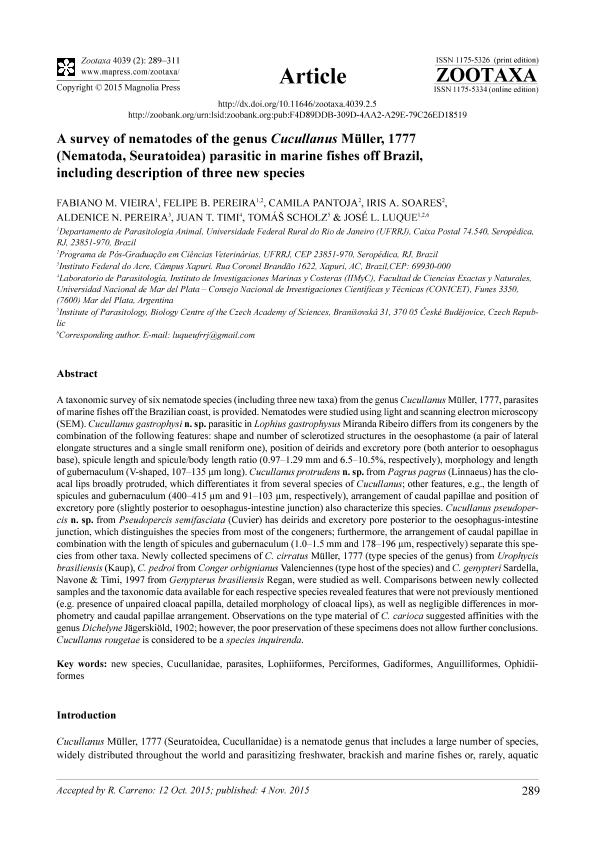Mostrar el registro sencillo del ítem
dc.contributor.author
Vieira, Fabiano M.
dc.contributor.author
Pereira, Felipe B.
dc.contributor.author
Pantoja, Camila
dc.contributor.author
Soares, Iris A.
dc.contributor.author
Pereira, Aldenice N.
dc.contributor.author
Timi, Juan Tomas

dc.contributor.author
Scholz, Tomás
dc.contributor.author
Luque, José L.
dc.date.available
2018-06-29T19:24:03Z
dc.date.issued
2015-11
dc.identifier.citation
Vieira, Fabiano M.; Pereira, Felipe B.; Pantoja, Camila; Soares, Iris A.; Pereira, Aldenice N.; et al.; A survey of nematodes of the genus Cucullanus Müller, 1777 (Nematoda, Seuratoidea) parasitic in marine fishes off Brazil, including description of three new species; Magnolia Press; Zootaxa; 4039; 2; 11-2015; 289-311
dc.identifier.issn
1175-5326
dc.identifier.uri
http://hdl.handle.net/11336/50783
dc.description.abstract
A taxonomic survey of six nematode species (including three new taxa) from the genus Cucullanus Müller, 1777, parasites of marine fishes off the Brazilian coast, is provided. Nematodes were studied using light and scanning electron microscopy (SEM). Cucullanus gastrophysi n. sp. parasitic in Lophius gastrophysus Miranda Ribeiro differs from its congeners by the combination of the following features: shape and number of sclerotized structures in the oesophastome (a pair of lateral elongate structures and a single small reniform one), position of deirids and excretory pore (both anterior to oesophagus base), spicule length and spicule/body length ratio (0.97-1.29 mm and 6.5-10.5%, respectively), morphology and length of gubernaculum (V-shaped, 107-135 m long). Cucullanus protrudens n. sp. from Pagrus pagrus (Linnaeus) has the cloacal lips broadly protruded, which differentiates it from several species of Cucullanus; other features, e.g., the length of spicules and gubernaculum (400-415 m and 91-103 m, respectively), arrangement of caudal papillae and position of excretory pore (slightly posterior to oesophagus-intestine junction) also characterize this species. Cucullanus pseudopercis n. sp. from Pseudopercis semifasciata (Cuvier) has deirids and excretory pore posterior to the oesophagus-intestine junction, which distinguishes the species from most of the congeners; furthermore, the arrangement of caudal papillae in combination with the length of spicules and gubernaculum (1.0-1.5 mm and 178-196 m, respectively) separate this species from other taxa. Newly collected specimens of C. cirratus Müller, 1777 (type species of the genus) from Urophycis brasiliensis (Kaup), C. pedroi from Conger orbignianus Valenciennes (type host of the species) and C. genypteri Sardella, Navone & Timi, 1997 from Genypterus brasiliensis Regan, were studied as well. Comparisons between newly collected samples and the taxonomic data available for each respective species revealed features that were not previously mentioned (e.g. presence of unpaired cloacal papilla, detailed morphology of cloacal lips), as well as negligible differences in morphometry and caudal papillae arrangement. Observations on the type material of C. carioca suggested affinities with the genus Dichelyne Jägerskiöld, 1902; however, the poor preservation of these specimens does not allow further conclusions. Cucullanus rougetae is considered to be a species inquirenda.
dc.format
application/pdf
dc.language.iso
eng
dc.publisher
Magnolia Press

dc.rights
info:eu-repo/semantics/openAccess
dc.rights.uri
https://creativecommons.org/licenses/by-nc-sa/2.5/ar/
dc.subject
Anguilliformes
dc.subject
Cucullanidae
dc.subject
Gadiformes
dc.subject
Lophiiformes
dc.subject
New Species
dc.subject
Ophidiiformes
dc.subject
Parasites
dc.subject
Perciformes
dc.subject.classification
Otras Ciencias Biológicas

dc.subject.classification
Ciencias Biológicas

dc.subject.classification
CIENCIAS NATURALES Y EXACTAS

dc.title
A survey of nematodes of the genus Cucullanus Müller, 1777 (Nematoda, Seuratoidea) parasitic in marine fishes off Brazil, including description of three new species
dc.type
info:eu-repo/semantics/article
dc.type
info:ar-repo/semantics/artículo
dc.type
info:eu-repo/semantics/publishedVersion
dc.date.updated
2018-06-29T13:11:00Z
dc.journal.volume
4039
dc.journal.number
2
dc.journal.pagination
289-311
dc.journal.pais
Nueva Zelanda

dc.journal.ciudad
Auckland
dc.description.fil
Fil: Vieira, Fabiano M.. Universidade Federal Rural do Rio de Janeiro; Brasil
dc.description.fil
Fil: Pereira, Felipe B.. Universidade Federal Rural do Rio de Janeiro; Brasil
dc.description.fil
Fil: Pantoja, Camila. Universidade Federal Rural do Rio de Janeiro; Brasil
dc.description.fil
Fil: Soares, Iris A.. Universidade Federal Rural do Rio de Janeiro; Brasil
dc.description.fil
Fil: Pereira, Aldenice N.. Instituto Federal do Acre; Brasil
dc.description.fil
Fil: Timi, Juan Tomas. Consejo Nacional de Investigaciones Científicas y Técnicas. Centro Científico Tecnológico Conicet - Mar del Plata. Instituto de Investigaciones Marinas y Costeras. Universidad Nacional de Mar del Plata. Facultad de Ciencia Exactas y Naturales. Instituto de Investigaciones Marinas y Costeras; Argentina
dc.description.fil
Fil: Scholz, Tomás. Biology Centre of the Czech Academy of Sciences; República Checa
dc.description.fil
Fil: Luque, José L.. Universidade Federal Rural do Rio de Janeiro; Brasil
dc.journal.title
Zootaxa

dc.relation.alternativeid
info:eu-repo/semantics/altIdentifier/doi/https://dx.doi.org/10.11646/zootaxa.4039.2.5
dc.relation.alternativeid
info:eu-repo/semantics/altIdentifier/url/https://biotaxa.org/Zootaxa/article/view/zootaxa.4039.2.5
Archivos asociados
